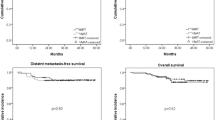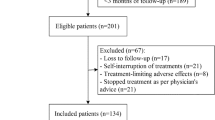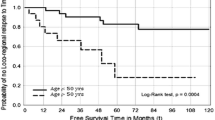Abstract
The present study intends to explore the influence of intensity-modulated radiation therapy on the quality of life for patients with nasopharyngeal carcinoma, which provides a theoretical basis and practical foundation for clinical practice. The present study randomly enrolled 130 cases of patients with nasopharyngeal carcinoma (NPC) in different stages who were admitted in The Second Affiliated Hospital of Fujian Medical University and the First Affiliated Hospital of Chongqing Medical University from September 2007 to August 2012, including 65 cases in IMRT group who received intensity-modulated radiation therapy and 65 cases in CRT group who received conventional radiation therapy. The prescribed dose in the target region of radical radiation therapy was 72 Gy/36 f; the prescribed dose in the target region at high risk was 60–64 Gy/30–32 f; the prescribed dose in the target region at low risk was 50–54 Gy/25–27 f and 2 Gy/f, with conventional fractionated irradiation of 1 f/d and 5 f/w. The data of the quality of life for patients with NPC who received intensity-modulated radiation therapy and conventional radiation therapy were collected and analyzed by filling in the questionnaire survey, including the Quality of Life Questionnaire of Head and Neck 35 (QLQ-H&N35) and Shot Form 36 Health Survey Questionnaire (SF-36). RP, VT, BP, SF, and RE scores in eight fields in SF-36 Scale were declined during the radiation therapy and risen again after radiation therapy, and those measured at 6 months after radiation therapy were higher than those before radiation therapy (all P < 0.05). The scores in IMRT group measured at two and six months after radiation therapy were all higher than those in CRT group (all P < 0.05). The scores of head and neck pain, pararthria, dysphagia, social difficulty, sensory difficulty, difficulty in feeding, xerostomia, cough, sticky saliva, and sensory discomfort during the radiation therapy were lower than those before radiation therapy (all P < 0.05). Except for the scores of sticky saliva and xerostomia, the other scores measured at 6 months after radiation therapy were all lower than those before radiation therapy, and the scores of dysphagia, sticky saliva, and xerostomia in MRT group were lower than those in CRT group (all P < 0.05). Conventional radiation therapy and intensity-modulated radiation therapy can cause a decline the quality of life for the patient with head and neck cancer, but intensity-modulated radiation therapy can improve local tumor control rate and significantly reduce the incidence of adverse reactions.
Similar content being viewed by others
References
Stelter, P., & Hurt, E. A. (2014). Pulse-chase epitope labeling to study cellular dynamics of newly synthesized proteins: A novel strategy to characterize NPC biogenesis and ribosome maturation/export[J]. Methods in Cell Biology, 122, 147–163.
Berger, M. L., et al. (2014). A questionnaire to assess the relevance and credibility of observational studies to inform health care decision making: An ISPOR-AMCP-NPC good practice task force report[J]. Value Health, 17(2), 143–156.
Hui, K. F., & Chiang, A. K. (2014). Combination of proteasome and class I HDAC inhibitors induces apoptosis of NPC cells through an HDAC6-independent ER stress-induced mechanism[J]. International Journal of Cancer, 135(12), 2950–2961.
Lee, F. K., et al. (2014). Dosimetric difference amongst 3 techniques: TomoTherapy, sliding-window intensity-modulated radiation therapy (IMRT), and RapidArc radiation therapy in the treatment of late-stage nasopharyngeal carcinoma (NPC) [J]. Medical Dosimetry, 39(1), 44–49.
Rosales-Perez, S., et al. (2014). Expression of Epstein–Barr virus-encoded latent membrane protein (LMP-1), p16 and p53 proteins in nonendemic nasopharyngeal carcinoma (NPC): A clinicopathological study[J]. Archives of Medical Research, 45(3), 229–236.
Jansen, J. P., et al. (2014). Indirect treatment comparison/network meta-analysis study questionnaire to assess relevance and credibility to inform health care decision making: an ISPOR-AMCP-NPC good practice task force report[J]. Value Health, 17(2), 157–173.
Chien, J. M., et al. (2014). The mechanism of NPC-14686-induced [Ca(2)(+)]i rises and non-Ca(2) (+)- triggered cell death in MG63 human osteosarcoma cells[J]. Chinese Journal of Physiology, 57(3), 158–166.
Flemming, D., Stelter, P., & Hurt, E. (2014). Utilizing the Dyn2 dimerization-zipper as a tool to probe NPC structure and function[J]. Methods in Cell Biology, 122, 99–115.
Su, S. F., et al. (2013). Analysis of dosimetric factors associated with temporal lobe necrosis (TLN) in patients with nasopharyngeal carcinoma (NPC) after intensity modulated radiation therapy[J]. Journal of Radiation Oncology, 8, 17.
Feng, X., Ching, C. B., & Chen, W. N. (2012). EBV up-regulates cytochrome c through VDAC1 regulations and decreases the release of cytoplasmic Ca2+ in the NPC cell line[J]. Cell Biology International, 36(8), 733–738.
Shimizu, S., et al. (2014). Early results of urethral dose reduction and small safety margin in intensity-modulated radiation therapy (IMRT) for localized prostate cancer using a real-time tumor-tracking radiation therapy (RTRT) system[J]. Journal of Radiation Oncology, 9, 118.
Lee, B., et al. (2014). Radiation therapy-induced secondary cancer risk for breast cancer: 3D conformal therapy versus IMRT versus VMAT[J]. Journal of Radiological Protection, 34(2), 325–331.
Chin, A. L., et al. (2014). Feasibility and limitations of bulk density assignment in MRI for head and neck IMRT treatment planning[J]. Journal of Applied Clinical Medical Physics, 15(5), 4851.
Johnson, D., et al. (2014). A simple model for predicting the signal for a head-mounted transmission chamber system, allowing IMRT in vivo dosimetry without pretreatment linac time[J]. Journal of Applied Clinical Medical Physics, 15(4), 4842.
Olteanu, L. A., et al. (2014). Comparative dosimetry of three-phase adaptive and non-adaptive dose-painting IMRT for head-and-neck cancer[J]. Radiotherapy and Oncology, 111(3), 348–353.
Saenz, D. L., Paliwal, B. R., & Bayouth, J. E. (2014). A dose homogeneity and conformity evaluation between ViewRay and pinnacle-based linear accelerator IMRT treatment plans[J]. Journal of Medical Physics, 39(2), 64–70.
Mukesh, M. B., et al. (2014). Patient reported outcome measures (PROMs) following forward planned field-in field IMRT: Results from the Cambridge Breast IMRT trial[J]. Radiotherapy and Oncology, 111(2), 270–275.
Moteabbed, M., Yock, T. I., & Paganetti, H. (2014). The risk of radiation-induced second cancers in the high to medium dose region: a comparison between passive and scanned proton therapy, IMRT and VMAT for pediatric patients with brain tumors[J]. Physics in Medicine & Biology, 59(12), 2883–2899.
Leicher, B., et al. (2014). Dosimetric comparison of IMRT rectal and anal canal plans generated using an anterior dose avoidance structure[J]. Medical Dosimetry, 39(3), 272–275.
Hirose, Y., et al. (2014). Evaluation of different set-up error corrections on dose-volume metrics in prostate IMRT using CBCT images[J]. Journal of Radiation Research, 55(5), 966–975.
Author information
Authors and Affiliations
Corresponding author
Rights and permissions
About this article
Cite this article
Chen, J., Liu, P., Wang, Q. et al. Influence of Intensity-Modulated Radiation Therapy on the Life Quality of Patients with Nasopharyngeal Carcinoma. Cell Biochem Biophys 73, 731–736 (2015). https://doi.org/10.1007/s12013-015-0638-0
Published:
Issue Date:
DOI: https://doi.org/10.1007/s12013-015-0638-0




